This is the article that I wrote for the Norwegian Fjord Horse Registry (NFHR). I imagine it will be edited some before it gets published.
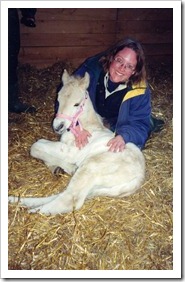 There is much that you can do during the first hours and days of your foal’s arrival to start them on the right hoof. Lessons learnt at this very important time, positive or negative, will shape the foal's behaviour for the rest of its life.
There is much that you can do during the first hours and days of your foal’s arrival to start them on the right hoof. Lessons learnt at this very important time, positive or negative, will shape the foal's behaviour for the rest of its life.
How then does one go about laying a good foundation? This was the question I set out to answer in the months leading up to the birth of our first foal. My first horse had been dangerously reactive and I knew I didn't want to repeat that scenario. Somewhere in all my reading I came across an article by Dr. Miller about his imprinting process (http://www.robertmmiller.com/imprint-training.html) - this seemed to be exactly what I was looking for! I quickly ordered his book and video, both of which I would recommend to anyone wanting to give their foal a good start. The knowledge learned there, combined with what I had learned from previous study of clicker training and operant conditioning gave me something to get started with. Over the years I added new techniques, including some from Parelli.
One April evening in 2000 our first foal, Uvaer, arrived. It was time to get started. While his mother, Dora, lay resting I started with imprinting - first towelling his body, then moving on to tapping his feet, rubbing his ears inside and out, slipping on a baby sized halter, rubbing with a plastic bag, introducing clippers, etc. All this was done in a calm and loving manner. I was careful not to frighten him or cause him undue stress. As we went through each step it was important to not stop until he was totally relaxed and accepting. Otherwise the opposite would happen - he would become sensitized to the stimulus, not at all what I was aiming for. After Dora was up I let Uvaer find his feet and have his first drink. While he was standing I went through the same steps, again making sure he remained calm. With my husband by his side to help his balance I gently lifted each foot, not putting it down until he was relaxed. With baby horse calm and accepting of us - step one was completed.
As a side note, I kept my own safety in mind while doing this. Some mares can get aggressive with anyone interfering with their new baby. I was always sure to either keep a barrier where the mare could still reach her foal, or had a helper manage the mare on a lead rope until their reactions could be gauged. I was fortunate that all our mares accepted our presence.
The following morning, I started Uvaer's next lessons. First we reviewed what was done in the initial imprinting. Any steps where there was resistance were repeated until a calm acceptance was achieved. Next on the agenda, the movement exercises. Uvaer had already learned from Dora to move from a nudge so we just built on this. In all of these exercises we started with a light pressure (or pull) and increased to an insistent (but not hard) pressure depending on the reaction we got. The aim was to have him move with just the lightest of touches.
Starting with the lead rope attached to the halter I applied a light (rope held between 2 fingers) pressure sideways, holding it until Uvaer moved his head to release the pressure. At that point I rewarded him by scratching his back. The release of pressure is also a reward but I wanted to additionally reinforce him. I repeated the exercise until he gave to the pressure right away at the lightest intensity. The exercise was repeated from the other side, and then from the front. Next I wanted to get a step in each direction. I just had to hold the pressure a little bit longer and he was stepping the right direction. More steps were added as he got more comfortable. Leading can also be done without ropes by using the pressure of your fingers.
The next skill to learn was stepping backwards and sideways. In other words, I wanted him to learn to move backwards with just a light pressure from my hand on his chest. I started by using one finger in the middle of his chest to ask him to move. The pressure was increased from the lightest of touches to a more firm touch, releasing at the first sign of backwards motion. This was repeated, waiting till he gave just little more each time. It was only a minute or two before he was stepping backward. Then the same set of steps was repeated for moving his hind quarters over.
Uvaer now had a basic foundation on which to build. We also had a foal that was comfortable around people and who could easily become a Fjord horse bull. To somewhat alleviate this we would ask for a step back, or a side step or to give his head whenever we wanted to pet him, or whenever he came up to us. Everyday we practiced something: leading – with and without a lead rope, picking up his feet and moving his body around - things that would come in handy when it was time to learn how to pull a cart or carry a rider. This gave him lots of practice doing what we asked and led to a more willing horse.
As foals were born over the next several years I added extra steps and more skills. For example, since they were comfortable with plastic bags fluttering around them we grabbed a tarp for them to practice with. They would walk over the tarp, under the tarp, they would play with the tarp and drag it around. We added tires to step in and around. A pole on the ground was added. They would drag a bag of cans, rattling and bumping their legs. A saddle blanket would whoosh over their heads and onto their backs. Mom's saddle would lightly be held on their backs (no real weight though!). We'd pick their feet up using a rope. Everything was introduced in a step by step fashion making sure not to create a phobia. We wanted things to be fun for them. Lots of scratches and rubs were given out.
The foals would gladly leave mom in the pasture to come and play with us, even from the time they were a week or two old. The mares felt confident in our ability to keep their babies safe and would relax away from them.
If you have a foal due and want to build a good foundation I would highly recommend reading the Dr. Miller materials. Learning about clicker training and the concepts of operant conditioning will teach you how to break things down into tiny, achievable steps. Many of the level 1 Parelli games can be played with a foal. All these techniques properly applied will create a horse that is a joy to be with; however, those same techniques improperly applied may create the opposite. Keep it fun and calm.
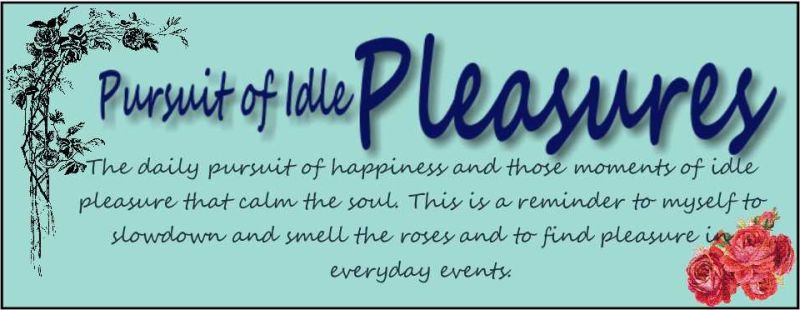

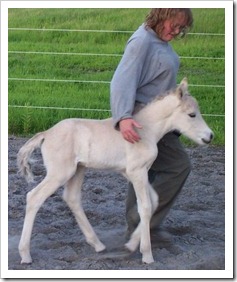
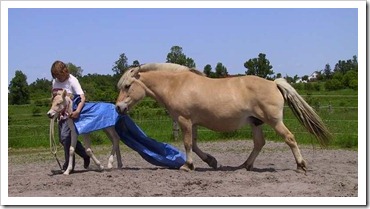

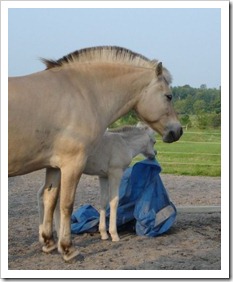
1 comment:
Very story write up:)
Post a Comment